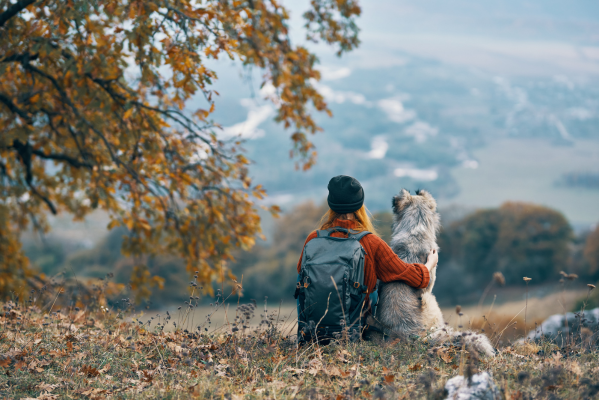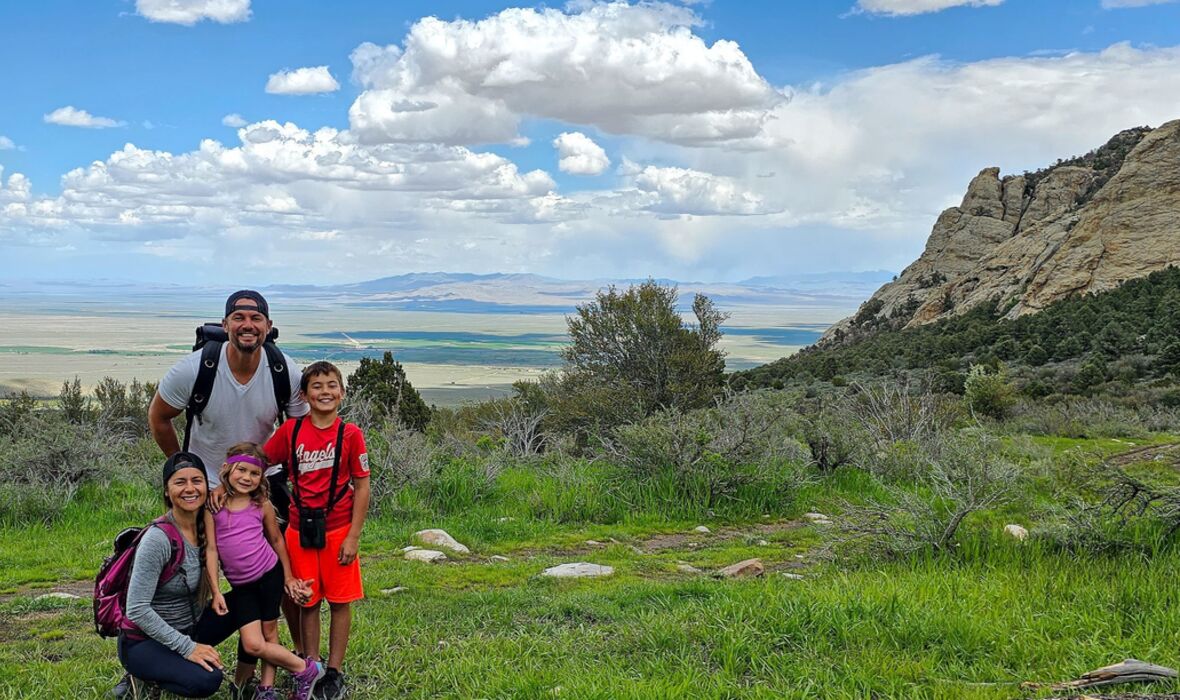RVing with your dog is one of those things that sounds romantic because it is. But as any honest traveler will tell you, it’s also a little messy, a lot of adjustment, and—if you do it well—a transformative experience.
You learn things. Not just about campgrounds, trails, and the great open road, but about presence, trust, and what it means to keep your special buddy safe while living just a few feet from the edge of the unknown.
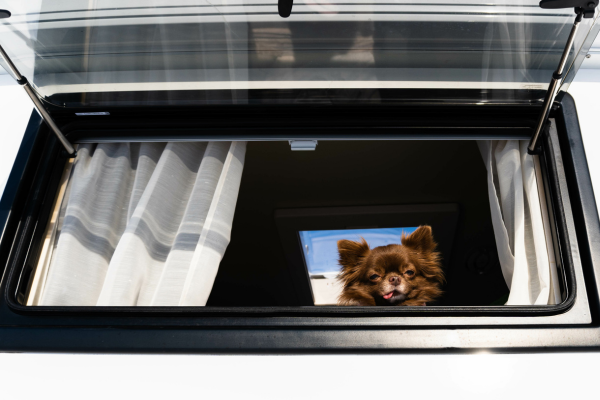
Dogs don’t need the map, but they do need the rhythm
While we humans often chase the thrill of the next destination, dogs are grounded in routine. And when the landscape is constantly changing, that routine becomes their compass.
Consistency around food, bathroom breaks, walks, and sleep signals security. Try not to deviate too much from your dog’s daily rhythms just because you’re camping on a beach or up in the high desert. Build your travel days around their biological needs—not just your mileage goals—and you’ll both be better for it.
Some dogs adjust quickly to the ebb and flow of travel life, while others may become withdrawn or anxious when their familiar landmarks disappear. Pay attention to their behavior. Are they eating normally? Resting well? Initiating play? These are signs they feel safe. If not, it might be worth staying put a little longer before moving on.
The rhythm doesn’t have to be rigid, but it should be intentional. Morning walks, mid-afternoon downtime, a cue before dinner. These rituals will make up the emotional scaffolding of your dog’s RV experience. They don’t care where you park. They care that they can count on you to help the day make sense.
- Stick to the same feeding times every day
- Start and end the day with the same walk routine
- Introduce new locations slowly with a familiar scent
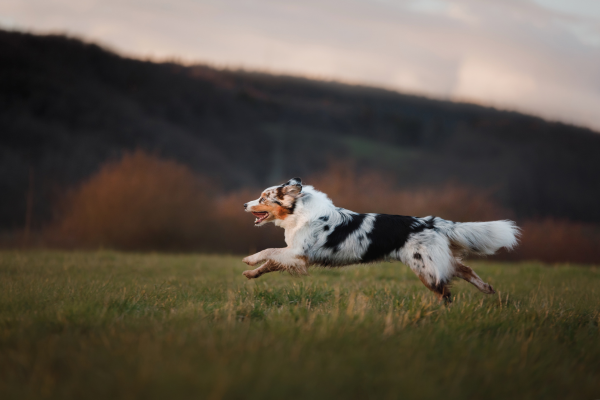
Research the RV park’s dog policies
You’ll find a spectrum of dog policies across RV parks—from open fields and treat jars at check-in to gravel squares barely big enough for a potty break. Pet-friendly doesn’t always mean pet-welcoming.
Do your homework. Sites like BringFido and Campendium include camper reviews that go beyond the rules and into the vibe. You’ll quickly learn which parks roll out the red carpet for dogs.Call ahead if you're unsure. Not all parks allow more than one dog, and some have breed restrictions. (Looking for dog-friendly travel guides or expert advice? Check more of Go RVing’s expert advice on RVing with pets!)
When you arrive, observe the environment before setting up. Is there shade? Is there a dog run? Are people walking dogs? Trust your gut. If the vibe isn’t right, it’s okay to move on. Your dog’s emotional safety matters as much as your hookups.
Even in dog-friendly places, consider your impact. Don’t let barking continue unchecked. Don’t leave waste behind. And remember that your well-mannered dog helps set the tone for the next traveler rolling in with theirs.
- Read RV park reviews ahead of time.
- Pack a long, retractable, and lockable lead if there's no dog run
- Always ask about leash rules and breed restrictions
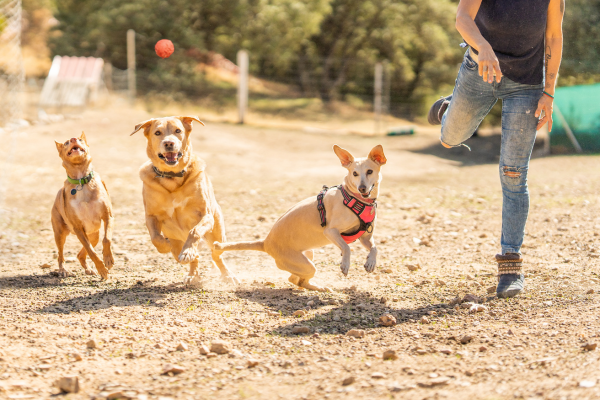
Boondocking with dogs requires a different kind of awareness
Camping off-grid can be paradise—for both of you. No leash laws. No neighbors. No rules beyond common sense. But that freedom brings a fresh set of responsibilities.
Keep your dog within sight. Coyotes, snakes, and other wildlife don’t play by campground rules. Use a long lead or secure tie-out system if your recall isn’t rock solid. Carry extra water. If you're camping in desert conditions, bring booties to protect paws from scorching sand and consider shade structures if there’s no natural cover.
The stillness of wild places can be both calming and risky. Know your dog’s triggers, and use that awareness to shape your setup. A shaded mat, a familiar toy, and a soft place to rest can turn unknown wilderness into a peaceful retreat.
Boondocking is also where your gear is most tested. Your dog’s tie-out, water bowl, even their ID tags take on new importance when you’re far from services. Run through a mental checklist every evening. The fewer surprises you invite, the more serenity you get in return.
- Use a 30-ft lead anchored to the RV or a tree, and consider a fence set up
- Pack extra water and collapsible bowls for hikes
- Bring a pet GPS tracker if your dog tends to roam
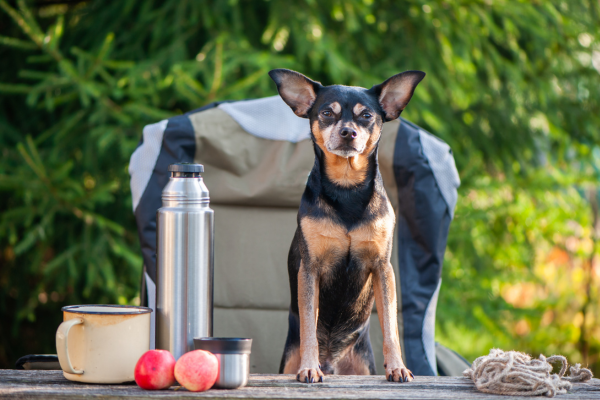
Dogs and noise: the barking dilemma
This is one of the most common questions new RVers ask: “What do I do if my dog barks too much?”
It starts with understanding why. Is your dog bored? Anxious? Overstimulated? All three?
Routine and adequate exercise are your first lines of defense. A dog who’s walked, fed, and given something to chew is far less likely to bark out of frustration. Beyond that, consider white noise machines, closing blinds, or even vet-approved calming aids.
Dogs don’t bark for no reason. If they’re telling you something, listen. Are neighboring dogs aggressive? Is there a pattern to when they bark? Does the barking stop when you’re nearby? Start treating barking like a message, not just a nuisance.
Training matters too. Teach a "quiet" cue and practice it daily. Reinforce silence with rewards. If barking is persistent, avoid environments where your dog is set up to fail. Noise isn't bad behavior—it’s communication. The real work is teaching better ways to be heard.
- Block views of foot traffic with curtains or blinds
- Give chews or frozen Kongs during stressful times
- Teach scent work or basic tricks on rainy days
- Use vet-approved calming aids or gear like ThunderShirts
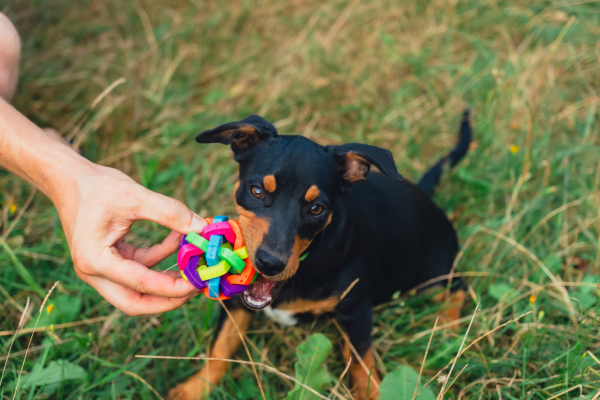
Packing for a dog on the road: minimal, not careless
Every item you bring in an RV has to earn its keep, and dog gear is no exception. Bring only what you truly need—but don’t skimp on what makes a difference.
That includes:
- Collapsible bowls for food and water. I personally use spill-proof bowls.
- Airtight food storage to keep critters (and odors) out
- Pet-safe wipes for muddy paws, trail grime, and post-hike stink
- A solid travel dog bed that is equipped to be outside, as well
- A basic first-aid kit with gauze, antiseptic, and a tick remover
- Weather gear like raincoats, cooling vests, or insulated jackets
- Paperwork: vaccinations (some parks require them), microchip info, vet contacts
- Leashes (short + long)
- Collar with updated ID tags
- Vaccination records (some parks require them)
- Medications
- Favorite toys or chews
- Dog sunscreen (especially for short-haired or light-skinned breeds)
- Portable shower attachment or rinse bucket - when towels just won’t cut it
Optional but awesome:
- Dog hiking backpack
- Pet-safe bug spray
- Paw balm for rocky trails or hot pavement
- Nose balm for dry weather (often an all-natural paw balm works well for the nose, too)
Multipurpose gear is key. A carabiner clip can hang a water bowl, for example. Choose items that pack well and serve more than one purpose.
Also consider a "go bag" for trail excursions or emergencies: a leash, poop bags, treats, a small bowl, and a copy of their ID. When the unexpected happens, you want to be ready to pivot fast.
- Bring a tick remover and tweezers for backcountry stops
- Use silicone travel bottles for shampoo or paw balm
- Keep gear organized in soft bins to reduce rattling
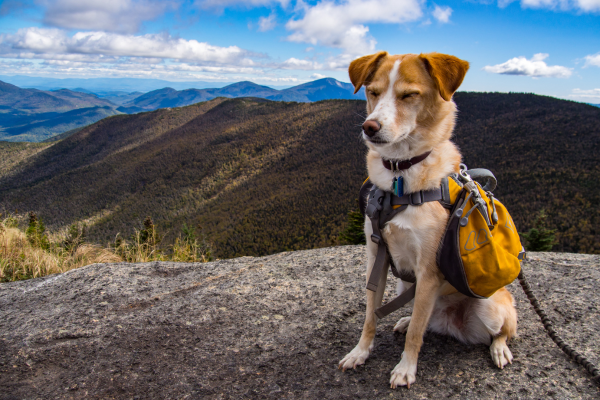
The real utility of a good dog bed
After a long day on the trail, dogs don’t want a novelty—they want familiarity. Something that smells like home. Something that supports aging joints and tired paws. A towel won’t cut it, and neither will a plushy gimmick you bought last-minute at a roadside pet store.
I recommend the RuffRest Ultimate Dog Bed (yep, I’m biased)! An orthopedic, road-tested dog bed made specifically for small spaces like RVs, and rooftop tents, it also folds, stores items, zips shut, and carries an integrated 3-season sleeping bag. Along with comfort, its familiar smells from home gives it continuity.
An RV dog bed should serve more than one function. The creators at Timberdog designed RuffRest with layers of foam for long-term support, washable covers for trail grime, and insulated padding for unpredictable climates. It fits into nooks and tucks under seats when not in use, but when unrolled, it becomes the psychological anchor of your dog’s space.
There’s something inherently satisfying about watching your dog curl up in the same bed at a windswept beach campsite as they did under the redwoods last week. It becomes more than gear. It becomes a portable sense of place. And in a life where everything is changing all the time, that’s a gift.
- Choose a low-profile bed with washable covers for easy cleanup
- Let your dog sleep on the bed before travel to create smells and a comfort association
- Store it somewhere accessible so it’s always the first thing down at camp
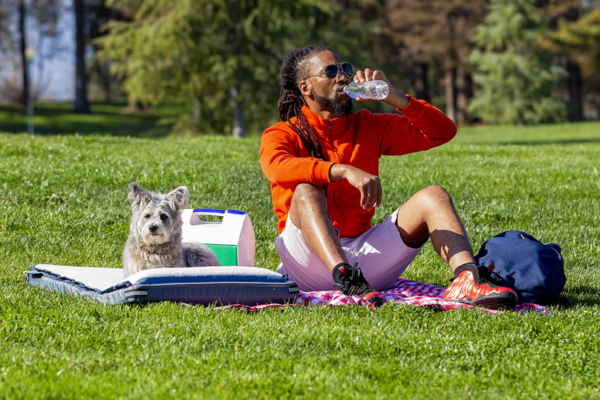
Trail rules, trail respect
RVing often means hiking—and hiking with a dog is its own joy. But it comes with etiquette. Keep dogs leashed in areas that require it. Yield to other hikers. Step aside when passing, and always pack out waste, even on backcountry trails.
Use trail apps like AllTrails, which allow you to filter by "dog-friendly" and read notes from other hikers about terrain, water access, and shade. And know your dog’s limits. Not every pup is built for rocky scrambles or 10-mile loops, and that’s okay.
Trail fatigue shows up fast. Watch for lagging, excessive panting, or refusal to continue. Carry water for both of you. Take breaks in the shade. And always leave the trail better than you found it. The way you hike today determines whether dogs are allowed tomorrow.
- Choose trails with water access if possible
- Bring a cooling bandana or vest for summer hikes
- Avoid trails with ladders, hot surfaces, or scree fields
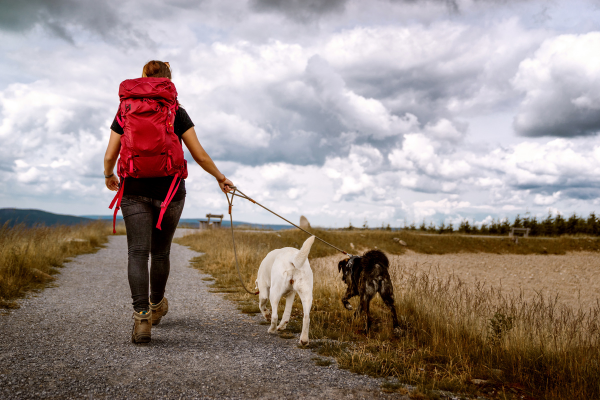
Hidden-gem campsites that are dog friendly
Some top camping faves among the RV + dog crowd:
- Coconino National Forest, AZ – dispersed camping, pine trees, dog heaven
- Cape Lookout State Park, OR – oceanfront sites and dog-friendly beaches
- Grand Staircase-Escalante, UT – dogs allowed on most trails
- Pisgah National Forest, NC – rivers, trails, shade — perfect for pups
Best Apps for RVers With Dogs
- BringFido – dog-friendly lodging, restaurants, and parks
- RV Life – campground reviews with pet info
- Waggle – temperature & humidity monitor for your RV
- AllTrails – filter for dog-friendly hiking trails
- Google Maps – search “off-leash dog park near me” before every stop
(Always verify local leash laws. Even “dog-friendly” spots have their own quirks.)

How RV life changes your dog—if you let it
Something beautiful happens when a dog spends weeks—or months—outside the four walls of a house. They slow down. They sniff more. They learn to wait, to watch, to nap when it’s hot, and to perk up when the door swings open to something new.
They don’t know the name of the national park, but they know the feeling of cool pine needles underfoot. They don’t care about the elevation marker, but they understand your joy when you reach the ridge. And they don’t measure time in miles—but in the next adventure yet to unfold.
Give them space to evolve. Maybe your city-dog stops reacting to every sound. Maybe your anxious rescue finds confidence in morning trailhead rituals. RV life doesn’t just challenge you to live differently. It can quietly transform your dog into the version of themselves they were meant to be.
- Journal your dog's behavior over time to notice patterns
- Take photos of them in each new place to track their journey
- Let them nap without guilt—they're recalibrating too
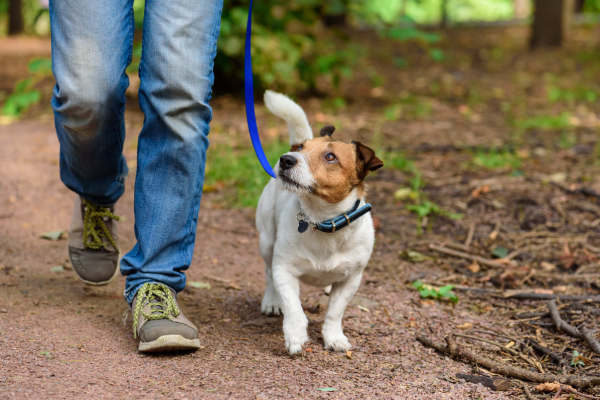
You bring the map. They bring the meaning.
RVing with your dog isn’t about achieving peak adventure. It’s about the quiet ways you learn to adapt to each other. It’s about leaving space in your plans for wagging tails, muddy paws, inconvenient potty breaks, and unexpected detours that turn out to be your favorite memories.
So build them a space of their own. Let them rest well. Let them wander wisely. Let them show you how to be rooted—even in motion.
Because in the end, they’re not just coming along for the ride. They are the reason the ride matters.
